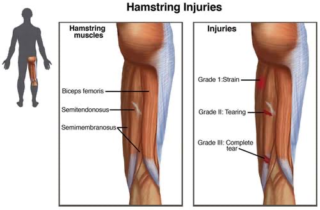Conditions
Medical Conditions We Treat ..
Joints & Bones
Frozen Shoulder (Adhesive Capsulitis)
Neck & Spine
Degenerative Disc Disease(DDD)
Herniated Discs(Bulging Discs)/Slipped Disc
Muscles
Hamstrings Strains
One of the most common injuries in sport is the hamstring strain, as the hamstring muscles are very susceptible to tears and strains.
Hamstring strains are most common among sports that require a high degree of speed, power, and agility such as soccer, basketball, tennis, and football.
The hamstrings consist of three muscles :
- The biceps femoris
- The semitendinosus and
- The semimembranosus.
Of the three muscles that make up the collective hamstring muscles (biceps femoris, semimembranosus, and semitendinosus) strain injuries occur in the biceps femoris over 75% of the time.

Causes
- Athletic injuries. Most torn hamstrings are caused by extreme stretching or overload during a sport. The injury often happens to people who play sports like soccer, football, and ice hockey.
- Past hamstring injury. If you’ve torn your hamstring in the past, you’re more likely to tear it again. The risk is higher if you do an intense activity before you’re fully healed.
- Training too hard can overload your hamstrings and cause tears.
- Poor flexibility. If you have limited flexibility, certain movements may stretch your muscles too far.
In addition to athletes, older people are prone to hamstring tears. That’s because flexibility often declines with age.
Adolescent athletes, who are still growing, are also at risk. Since bone and muscle grow at different rates, the growing bone can tighten the hamstring muscles, making them more susceptible to injury.
Symptoms
- sudden, sharp pain
- a “popping” sensation at the time of injury
- tenderness
- swelling within the first few hours
- bruising within the first few days
- partial or complete weakness in your leg
- inability to place weight on your leg
Hamstring strains are classified as Grade 1–3 strains depending on severity. A hamstring strain may occur in one or more of the three muscles in the group.
| Grade | Description |
| 1 (mild) | · Overstretching without tearing of muscle or tendon fibers.
· Symptoms may not present until the activity is over. · Usually no loss of muscular strength or flexibility. · Increased tightness in the muscle during stretch or through a full range of motion. · A feeling of pain may be reported with sitting or while walking uphill or ascending stairs. · Depending on the severity, weight-bearing activities may or may not be possible, walking properly may be possible and there will be minimal swelling. |
| 2 (moderate) | · Partial tear in the muscle.
· Muscular strength and flexibility is reduced. · Pain is more immediate and more severe than the pain of a Grade 1 strain. · Pain on stretch and contraction of the muscle, and is usually sore to touch. · Limping is likely during walking and occasional sudden twinges of pain during activity may occur. · Bending the knee against resistance will cause pain and there may be some difficulty in fully straightening the knee. |
| 3 (severe) | · Severe or complete rupture of the muscle. Maybe a large lump (of muscle tissue) above a depression where the tear is.
· Sudden, sharp pain in the back of the thigh. · Walking is not possible without pain. · After a few days with Grade 2 and 3 injuries, a large bruise may appear below the injury site caused by bleeding within the tissues. · May require surgical repair. |
Risk factors
- Age: the older you are the more you are at risk for a strained hamstring.
- Previous Injury: Previous injuries to your hamstrings or adductor muscles can increase the risk of re-injury in the future.
- Flexibility: The greater the flexibility of your hamstrings the less prone they are to injury.
- Hamstring strength: Lack of hamstring strength is strongly linked to a chance of a pulled (strained) hamstring.
- Lumbosacral nerve impingement: Nerve impingement in your L5-S1 lower backbones can lead to related hamstring muscle weakness.
- Tiredness and fitness: When you are fatigued you lose coordination of muscle groups. The biceps femoris muscle is a hamstring muscle that has two separate nerves to help it work. When you are tired the nerves may not work together, you could pull your hamstring because one section is working while the other is not.
- Poor warm-up before explosive movements such as running, kicking, jumping.
Prevention:
- One of the most important ways to prevent a pulled hamstring is to warm up correctly and completely. Thermal pants and dynamic sport-specific exercise warm-ups are suggested to help with this.
- A specific strengthening program for your hamstring muscle group is important if you are a sprinter or compete in high-speed athletics.
- It is extremely important to continue to strengthen all other muscles in the thighs, pelvis, and lower back to make sure you have correct muscle balance.
- Stretching both before and after exercise.
- Regular deep tissue sports massage can help prevent muscle strains by identifying tight knots and weak points in the muscle.
